
‘Afraid of the water’? Life in a city that dumps billions of litres of raw sewage into lakes and rivers
10 billion litres of sewage are dumped into Winnipeg’s lakes and rivers each year. Some...
This is the seventh part of Carbon Cache, an ongoing series about nature-based climate solutions.
SUSSEX, N.B. — Melissa Labrador leans against an ancient red oak tree reaching onto the Wildcat River in southern Nova Scotia. It’s unusually dry due to a mid-August drought, but she can still smell the fresh herbal scent of wild blueberries, wintergreen and sun-warmed pine needles.
The red oak is her ancestor tree, a grandparent of the forest that holds old knowledge of her people, Mi’kmaq of the Gokqwes or Wildcat community, who have lived here for millennia.
“I like to think he was just barely growing when my people were going to the ocean, along this river in the birch bark canoes, picking medicines along the way,” Labrador says.
The oak is part of a tiny remnant of the endangered Acadian forest, also known as the Wabanaki Forest, one of the most diverse temperate forests in the world that is uniquely carbon dense and naturally fire resistant. It’s also the traditional home of Mi’kmaw and Wolastoqiyik, the First Peoples of the land.
Prior to colonization, giant hemlock, skyscraper eastern white pine, willowy yellow birch and red spruce enveloped the Maritime provinces, a transition zone made up of 32 species of evergreens and leafy trees. Now, less than one per cent of the original Acadian forest remains, pockets and stands reminiscent of mother nature’s great work of art.
To Labrador, the Acadian forest offers knowledge: traditional medicine, materials for building birch bark canoes and a place to connect with her ancestors. In the forest behind her bungalow and vegetable garden, she tells me that in Mi’kmaq culture, the large old-growth trees like this ancient red oak are healing trees.
Just as Labrador’s mother, father and grandfather taught her about how to conscientiously use what’s in the forest to survive, Labrador is passing that knowledge on to her nine-year-old twins, Nakuset and Tepkunaset: “If my people didn’t understand the medicines, we wouldn’t be here.”
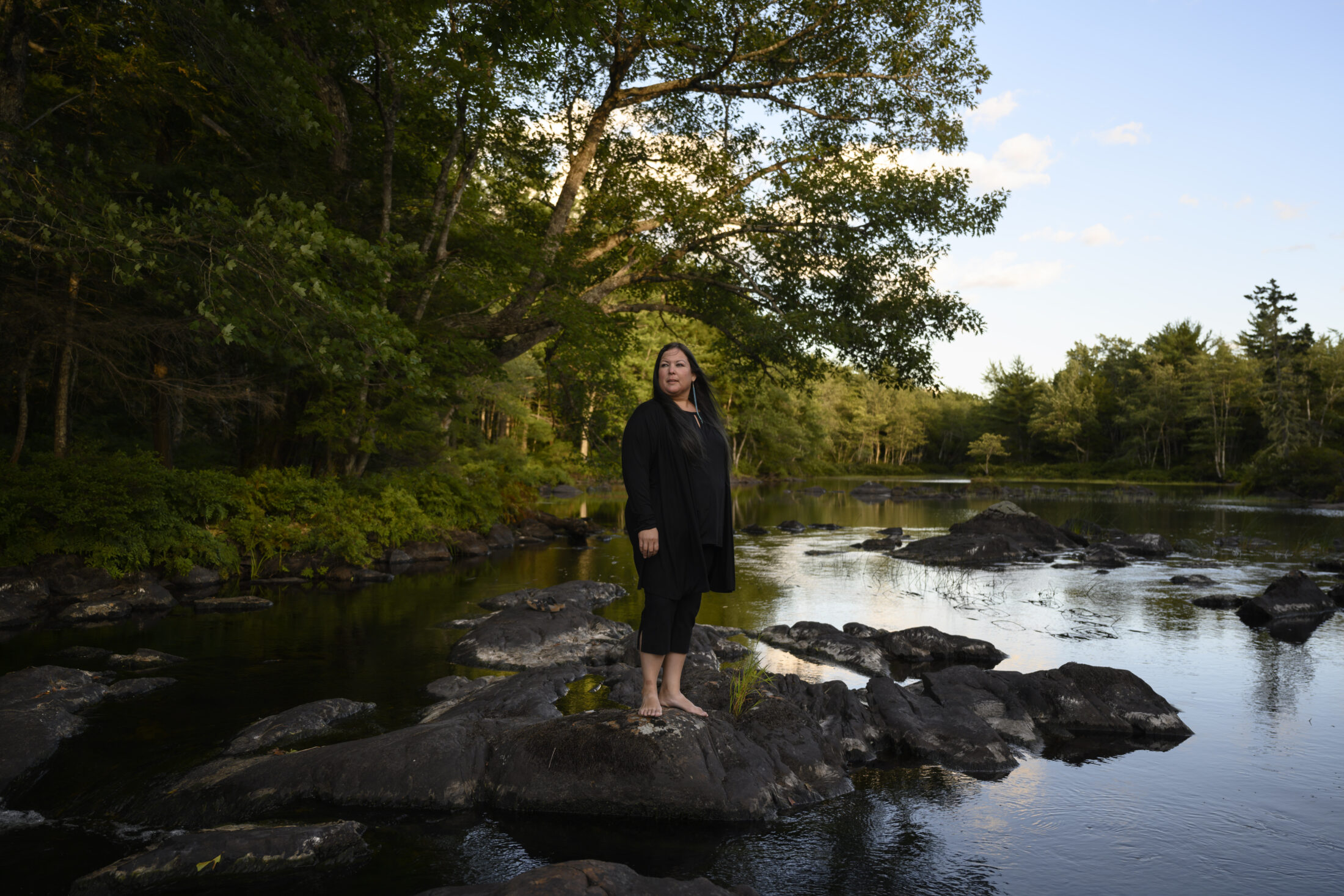
Knowledge keeper Melissa Labrador on the Wildcat River in front of a centuries-old oak tree that she considers a healing tree. The endangered Acadian forest, also known as the Wabanaki Forest, is the traditional home of Mi’kmaw and Wolastoqiyik, the First Peoples of the land. Photo: Darren Calabrese / The Narwhal
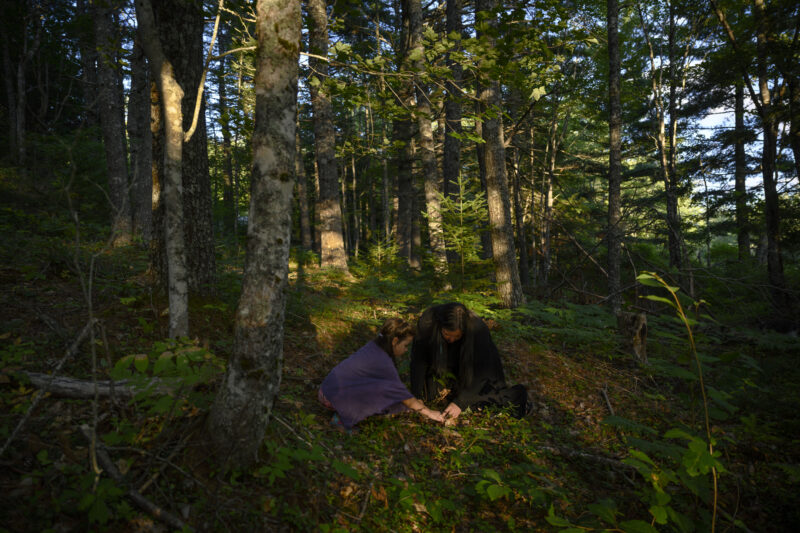
Melissa Labrador, right, with one of her twins, Nakuset, harvests medicinal plants in the Wildcat community of Acadia First Nation in Nova Scotia. Photo: Darren Calabrese / The Narwhal
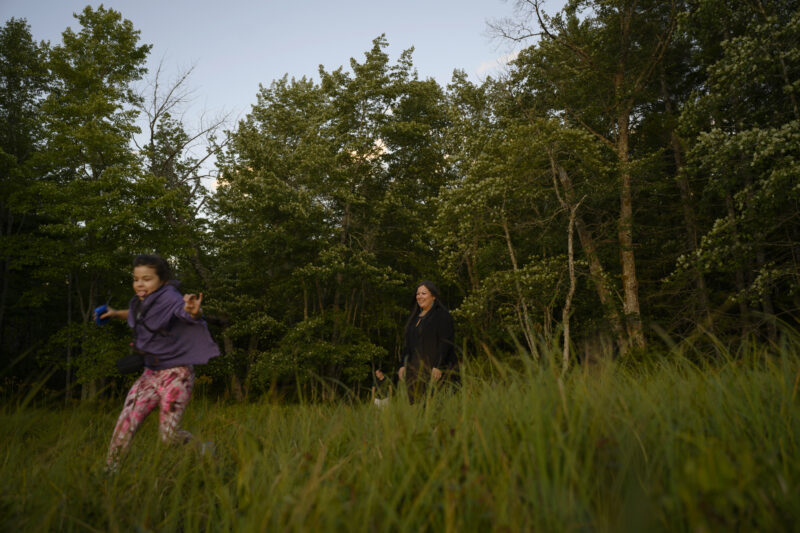
Melissa Labrador, right, laughs while watching Nakuset, one of her twins, running through the grass on the edge of the forest along the Wildcat River. Photo: Darren Calabrese / The Narwhal
The Acadian forest could also be much-needed medicine for the Earth’s warming climate. A 2017 study published in the Proceedings of the National Academy of Sciences found that nature-based climate solutions could provide more than one-third of the emissions reductions needed to stabilize global temperature increases below 2 C by 2030 under the Paris Accord.
As home to almost nine per cent of the Earth’s forests, Canada has a vital role to play in the global fight against climate change. One New Brunswick-based charity that works to save forests says restoring the Acadian forest has the potential to make a huge impact on reducing greenhouse gas emissions.
“We could store 20 million tonnes of greenhouse gas emissions over the next few years,” says Daimen Hardie, executive director of Community Forests International. “That’s three times more than the country produces every year.”
Could saving the Acadian forest be a panacea for climate change?
Warm sunlight filters through a stand of century-old hemlocks and towering large tooth aspens on the upper reaches of the east valley of Whaelghinbran Forest. Here in South Branch, near the town of Sussex, N.B., these trees provide one of the few last glimpses of what the Acadian forest would have looked like prior to European contact.
Hardie and forest ecologist Megan de Graaf have hiked with me here to show me what their forest restoration charity has saved from a certain clear-cut death. It smells at once ancient and fresh, shaded yet sunbaked with standing deadwood (a critical part of a healthy forest, according to de Graaf) and a canopy that radiates infinite shades of green. The only reason it survived logging is because of its location: a steep slope that made it practically impossible to access except by foot.
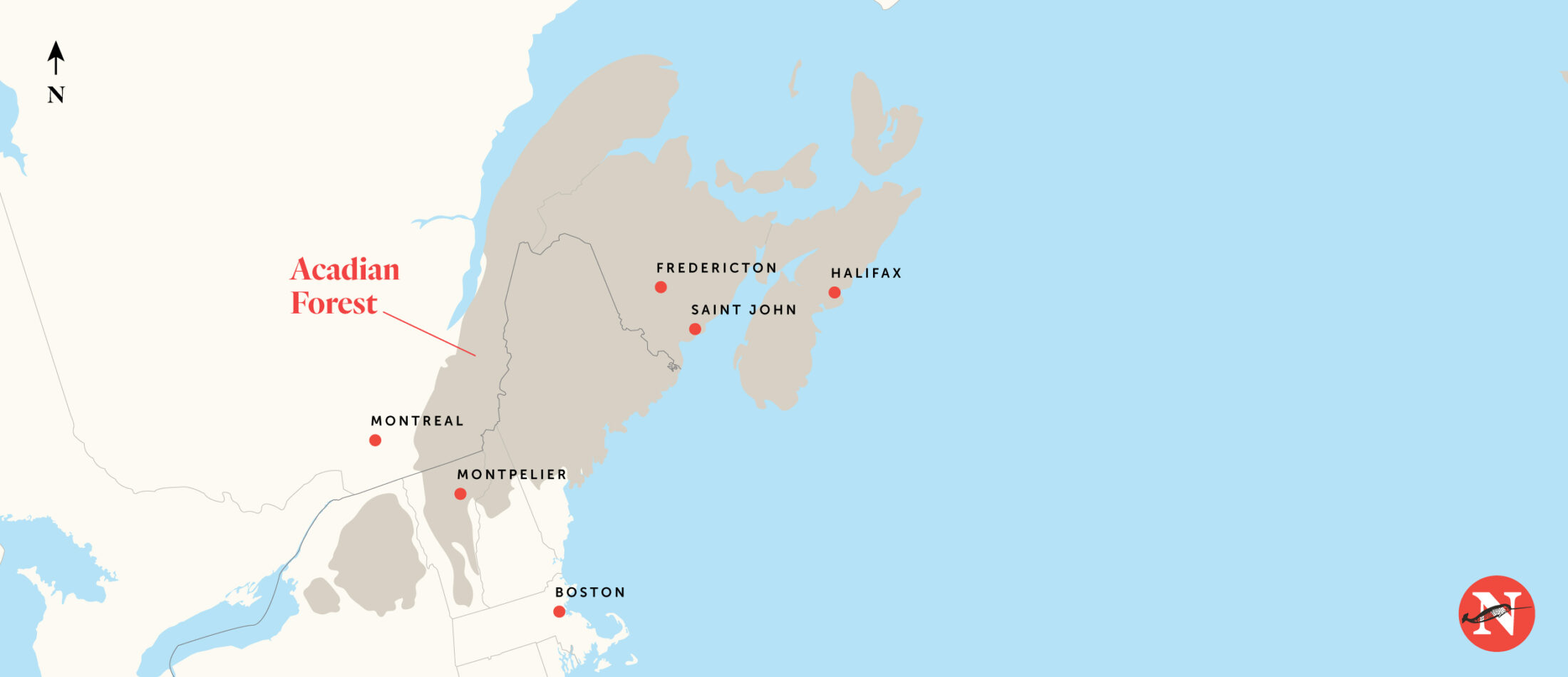
The extent of the Acadian forest. Map: Alicia Carvalho / The Narwhal
The vast majority of forests in Canada are on Crown or Indigenous lands, but forestry ownership in the East is unique, with 45 per cent of forest land in the Maritimes belonging to private woodlot owners. It’s not unusual for rural families, which make up roughly half the population, to have a back 40 — an acreage of forest where they chop their own firewood, hunt and walk in the woods.
There are about 80,000 small family forest owners across Prince Edward Island, New Brunswick and Nova Scotia, and each has on average 80 hectares — the equivalent of about 98 Canadian football fields per property owner. Due to an aging population and young people leaving, these families increasingly have no one to pass the land onto and are faced with the decision to clear cut or delay retirement.
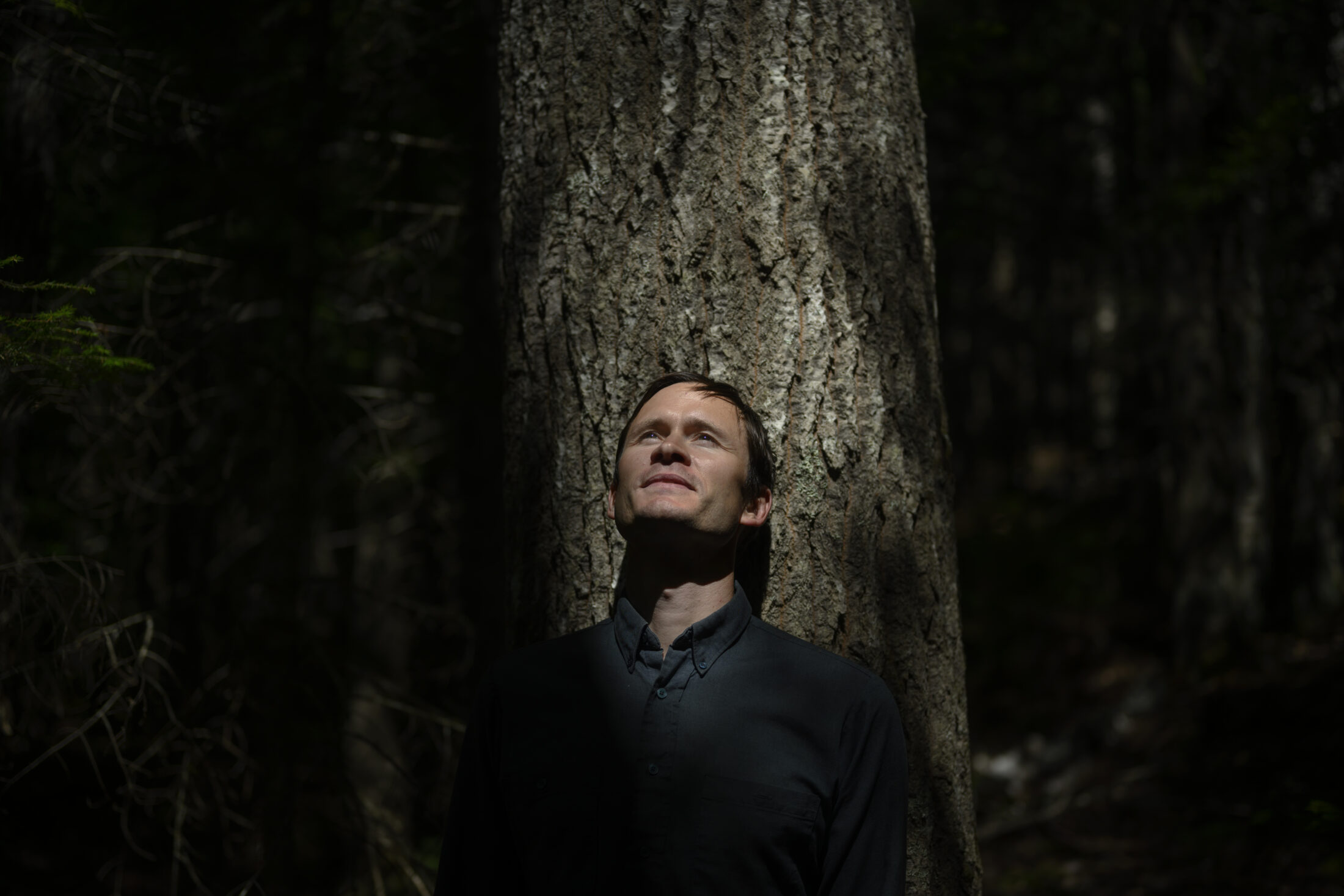
Daimen Hardie, co-founder of Community Forests International, leans on an aspen tree in the Acadian forest at Whaelghinbran Farm near Sussex, N.B. The forest could store 20 million tonnes of greenhouse gas emissions over the next few years, Hardie says. Photo: Darren Calabrese / The Narwhal
This was the conundrum Clark Phillips and Susan Tyler found themselves in about a decade ago. The New Brunswick couple ran a certified organic farm and restored their more than 400 hectares of Acadian forest at Whaelghinbran over their 40 years on the land. The two urged the forest back to its natural Acadian state, harvesting mature pioneer trees and selling them to the local mill, and this let more light into the forest. Their careful tending sped up the natural succession of the forest by 50 years.
“The Acadian forest is such a teacher and such a gift,” Tyler, 81, says. “If you respect it and don’t consider everything that isn’t a product a weed, then you get back everything.”
The couple needed to retire for health reasons and revenue to do so but they didn’t want to lose their beloved forest to an industry that would destroy their legacy.
“We didn’t want it clear cut,” Tyler says. “The Irving practice was usually to go into a piece of Crown land that had all these different species and clear cut it and then try to change what grew there into a farm crop and we didn’t want to see that happen to this beautiful piece of land.”
When Hardie and de Graaf heard about the couple’s predicament, they wanted to help but Community Forests International didn’t have the cash to buy the forest on its own. So they created a forest carbon project — the first in the Maritimes. They measured and quantified carbon storage on the forest land, had it certified by third-party standards and then sold the carbon offsets to the Toronto-based architecture and engineering firm DIALOG. A conservation easement was put on the land that ensures the forest stands forever. In the end, the organization raised enough money from selling the carbon offsets to buy the land for $400,000 and today, it is continuing to restore and protect Whaelghinbran.
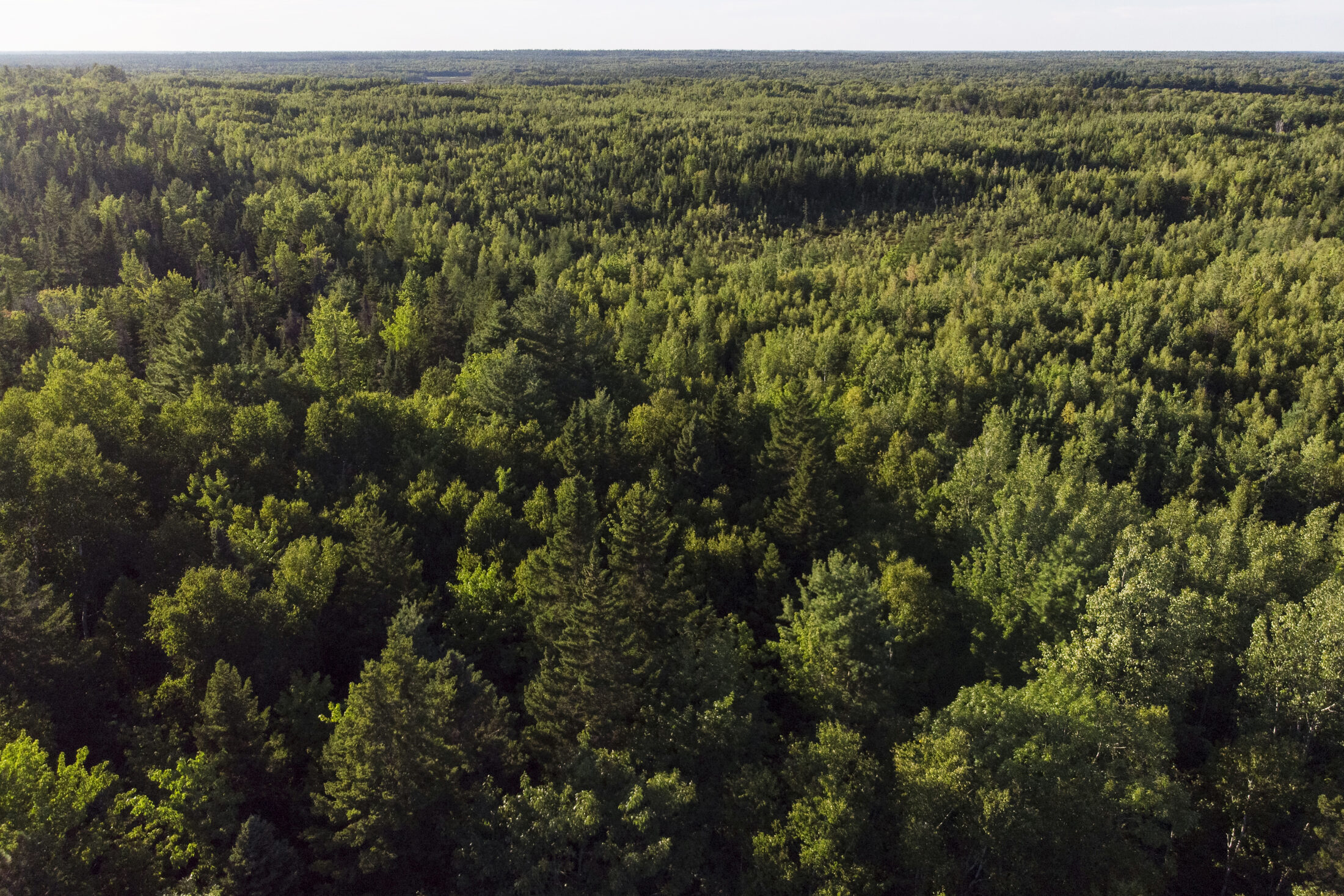
A privately owned Acadian forest woodlot in Douglas Harbour, N.B. There are more than 80,000 family woodlot owners in the Maritimes. Photo: Darren Calabrese / The Narwhal
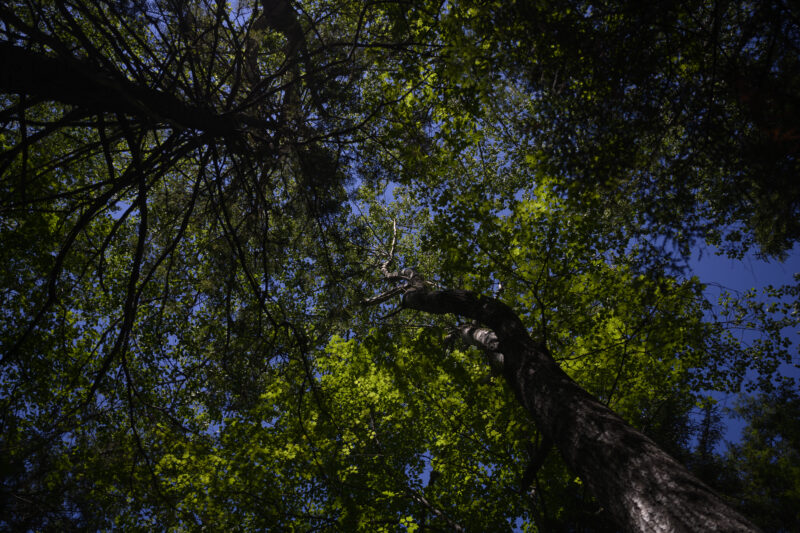
The mixed-wood canopy of aspen, red maple and hemlock trees in the Acadian forest. Photo: Darren Calabrese / The Narwhal
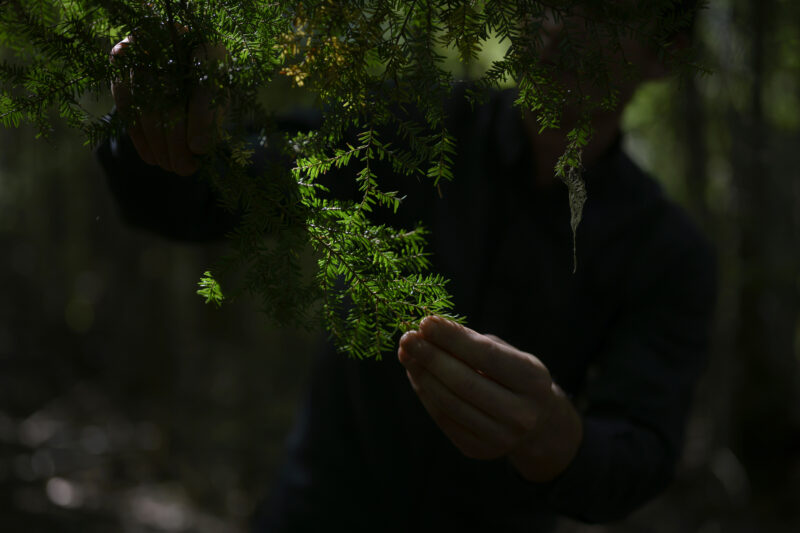
Hardie looks at hemlock tree needles in the mixed-wood Acadian forest. Photo: Darren Calabrese / The Narwhal
However, while the carbon forest project was underway, the couple was forced to sell off portions of the forest to survive — 46 hectares that has been clear cut (but was recently bought back by Community Forests International), and 66 hectares sold to individual citizens with easements to prevent clear-cutting.
Tyler says her and Clark’s legacy shows that we can live on a planet without destroying it. “We need to learn to live not as an invasive species. Live with the forest. I think that’s what we tried to do and that’s what we need to do,” she says, adding that ideally she’d like to see Whaelghinbran operate again as a farm someday.
To date, Community Forests International has stored more than 38,000 metric tonnes of carbon dioxide equivalent in three unique Wabanaki-Acadian forest preserves in southern New Brunswick, including 285 hectares at Whaelghinbran, one in Cambridge-Narrows and another in Waterford, totalling more than 1,200 hectares. The amount of carbon dioxide saved equals the greenhouse gas emissions of 8,229 passenger vehicles driven for a year.
“Whaelghinbran Forest is the living proof of what’s possible,” Hardie says, adding that if 80,000 family forest owners across the Maritimes did something similar, it would make a globally significant contribution to slowing climate change. “That would be what the Maritimes could offer the world.”
Forests store carbon dioxide by pulling it out of the atmosphere and pumping it into the ground, where it’s transformed into biomass — an ecological dumpster for nature’s garbage. Many people think about planting trees as a way to suck carbon out of the atmosphere without realizing how much carbon is stored in the soils, says forest ecologist de Graaf.
“That system underneath our feet actually stores as much, if not more, carbon than what is above us, the trees,” she says, adding that its role in stabilizing the climate is “huge.”
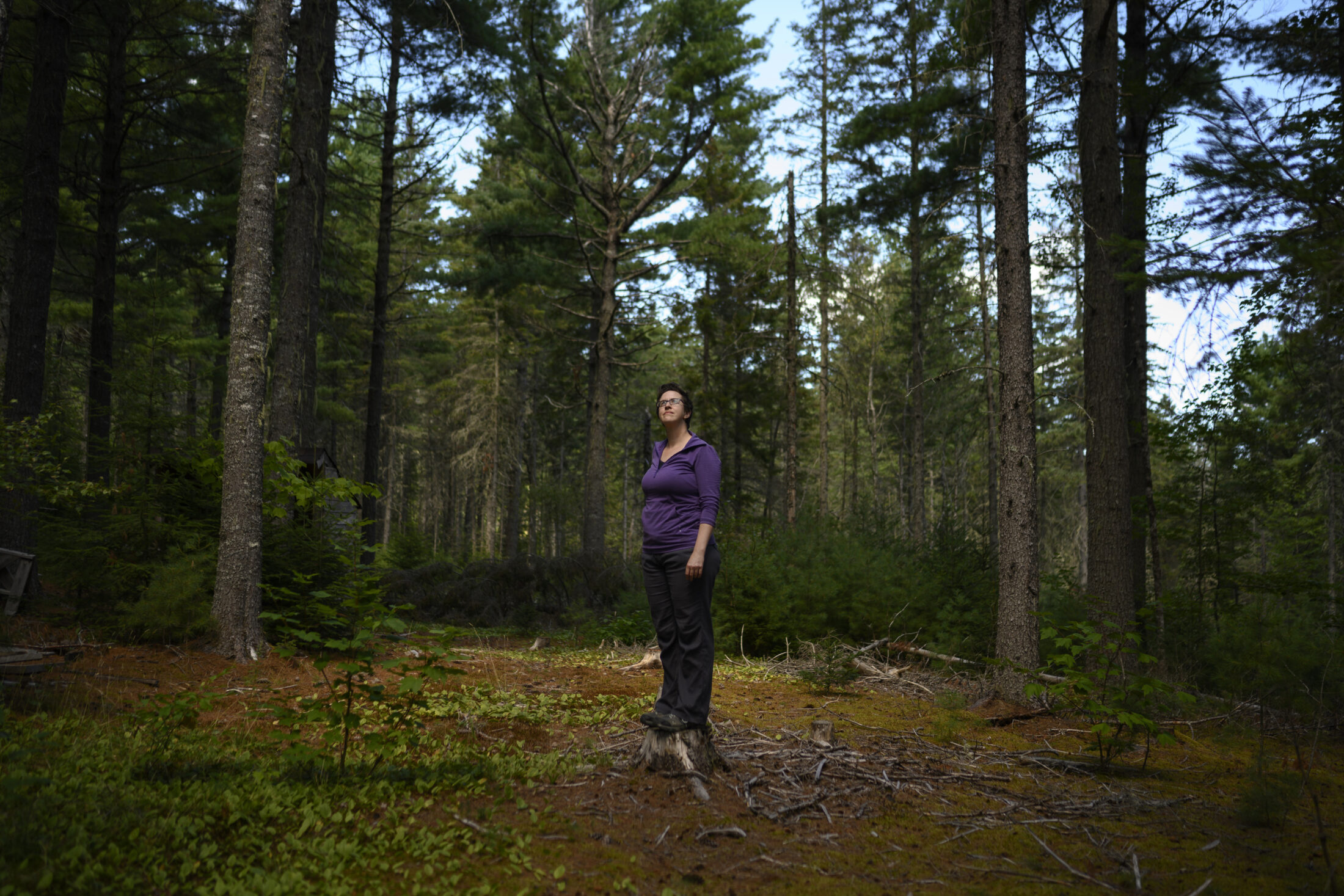
Megan de Graaf, forest program director with Community Forests International, says the soil beneath the forest stores as much — if not more — carbon than the trees themselves. Photo: Darren Calabrese / The Narwhal
The temperate forest of the northeastern United States has been calculated to offset 40 per cent of the greenhouse gas emissions of that same region, according to a 2011 University of Nebraska-Lincoln paper. “Keeping it in there, in the forest, is probably one of the key aspects in terms of carbon balance in the country,” says University of New Brunswick forest ecologist Loïc D’Orangeville.
Carbon offsetting is one way to reduce greenhouse gas levels through continuous storing of carbon in nature to compensate for emissions created elsewhere. It’s a popular climate change mitigation tool but it has also taken heat. Some international carbon offset programs have been found to be scams. They’ve also been criticized as “get out of jail free cards” for big polluters and likened to Catholic sins, a way for the guilty to pay for absolution rather than changing behaviour. Hardie says that outlook is counterproductive. “They’re meant to be a tool for transition to help people realize the greater value of our forests and ecosystems so that we can protect them better,” he says.
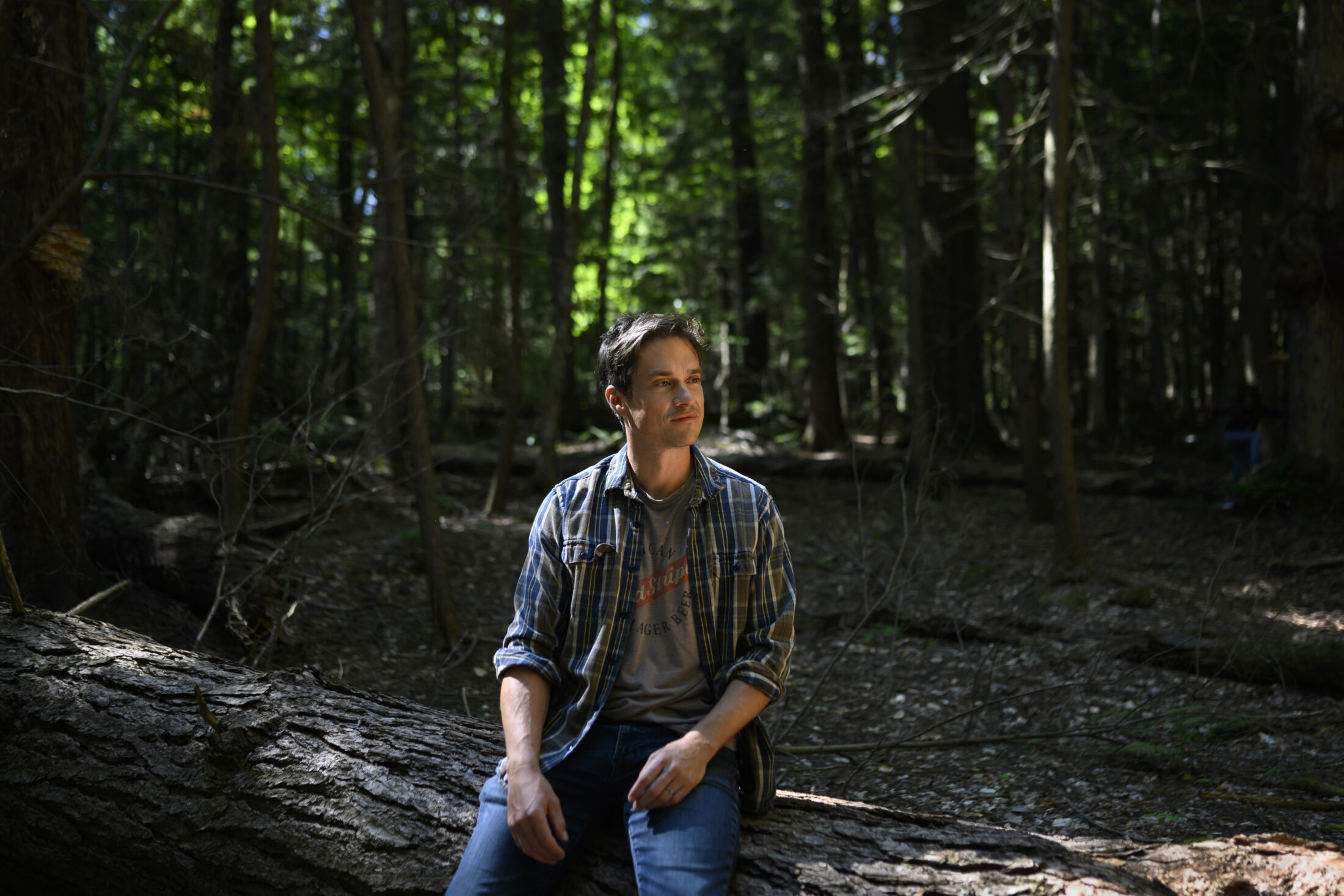
Loïc D’Orangeville, a forest ecologist at the University of New Brunswick, poses on a felled hemlock tree in Odell Park in Fredericton, N.B. Photo: Darren Calabrese / The Narwhal
When Europeans started living on unceded land in the Maritimes in the 18th century, logging focused almost exclusively on white pine to build masts for British sailing ships. By 1850, spruce, especially red spruce, became an important logging species. Logging focused on large trees in well-drained stands near rivers and streams for log driving. Hemlock was especially popular and was nearly wiped out because of the leather industry using its bark for tannins. From the 20th century onward, clear cuts, fire suppression and spruce budworm insecticide spraying, which has increased balsam fir abundance, have changed the makeup of many forests in the Maritimes to a monoculture of softwoods, money-makers in the pulp and paper industry.
Atlantic Canadian forests are a valuable natural resource in the region, particularly for the many rural communities where forest-related jobs are the main source of employment, according to the federal government. The Maritimes has some of the highest rates of clear cuts in the country, with New Brunswick removing forests from the landscape faster than they can be replaced, according to the Conference Board of Canada. New Brunswick also has the largest forestry industry in the country relative to the size of its gross domestic product — forestry, worth $1.29 billion in 2018, makes up 4.5 per cent of the provincial gross domestic product, according to Statistics Canada. In Nova Scotia, the forest sector contributes $328.8 million to the real gross domestic product, while on Prince Edward Island it contributes $34 million.
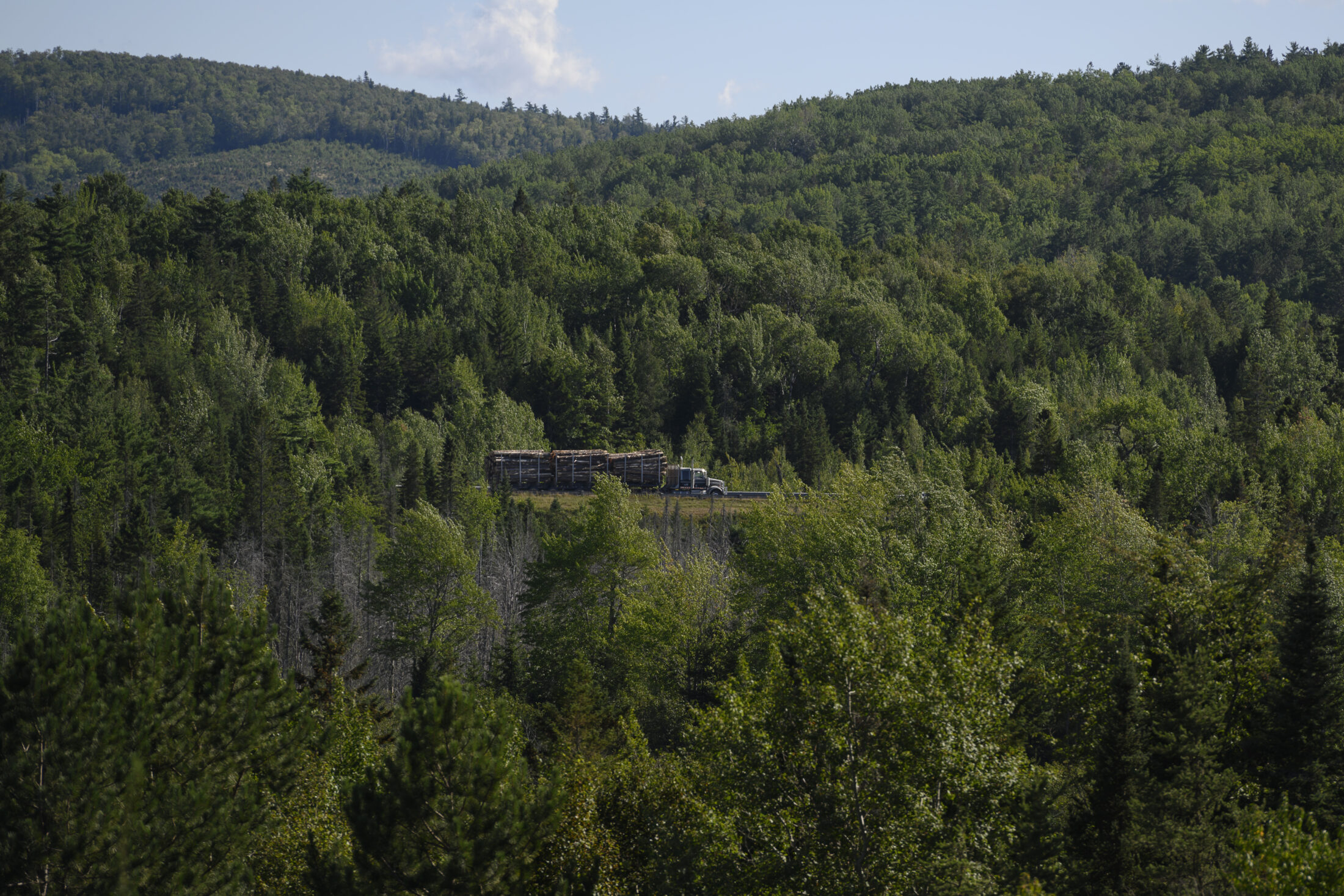
A logging truck carrying a load of wood is seen near a clearcut surrounded by the Acadian forest near Sussex, N.B. Photo: Darren Calabrese / The Narwhal
A typical industrial forest is cut every 40 to 70 years, breaking the natural process of succession and preventing the development of a diversity of species and ages that are characteristic of the Acadian forest. While human life is measured by lifespan and generations, the natural forest is wholly different. We live over decades. Trees live over centuries. Because of that, D’Orangeville says, we’ve lost touch with what a real natural Acadian forest should look like.
“The forest that you know today is not the forest that was,” says D’Orangeville, 38, who often takes his two young children to Fredericton’s Odell Park to show them the stand of 560-year-old hemlocks. “We always have a new normal. And that normal is shifting towards these younger, simpler forests with just one layer of trees, and not a multi-layered forest of young trees and old trees that is home to thousands of different species.”
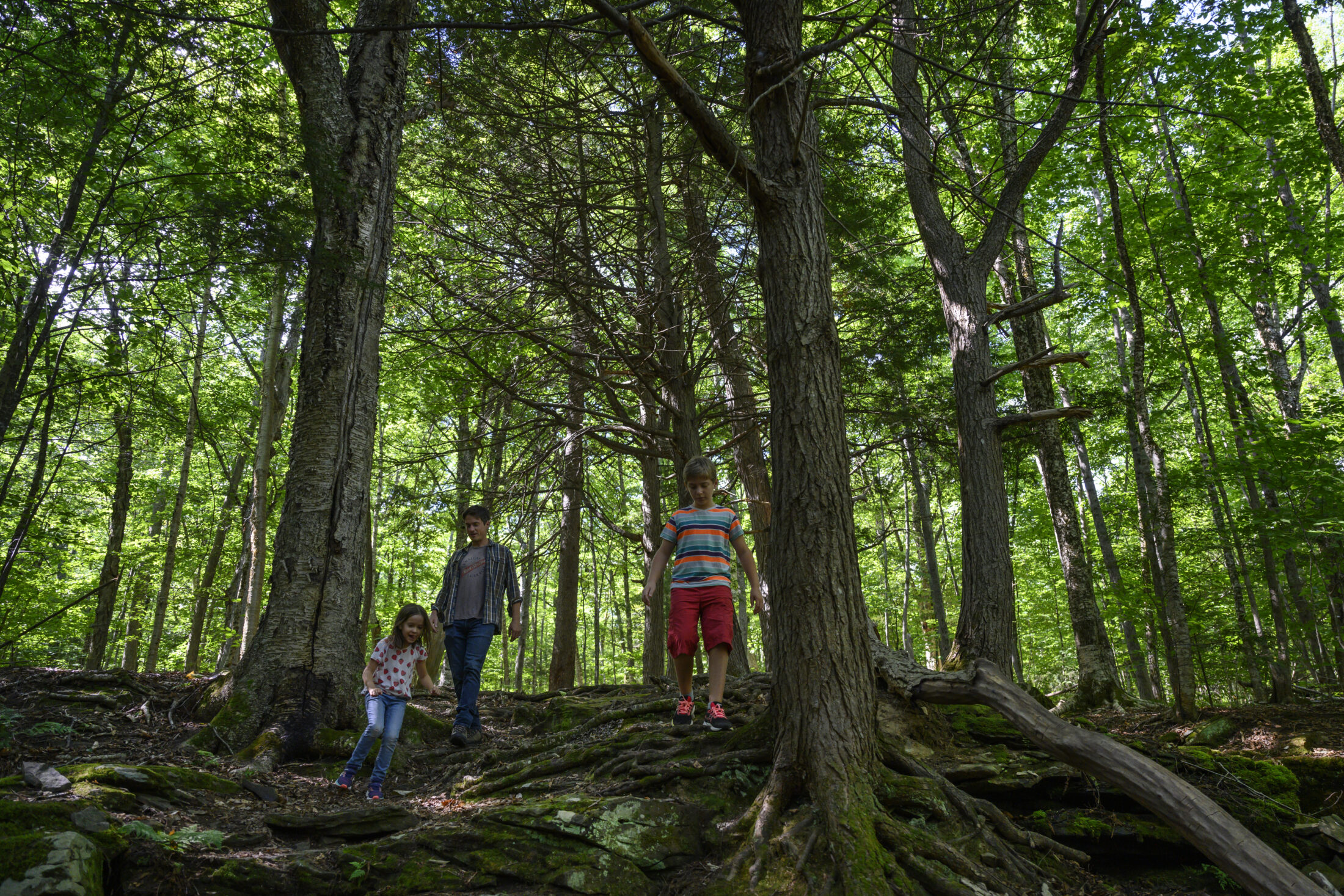
Loïc D’Orangeville, second from left, searches for mushrooms with his children Elise, left, and Lucas in Odell Park in Fredericton, N.B. Photo: Darren Calabrese / The Narwhal
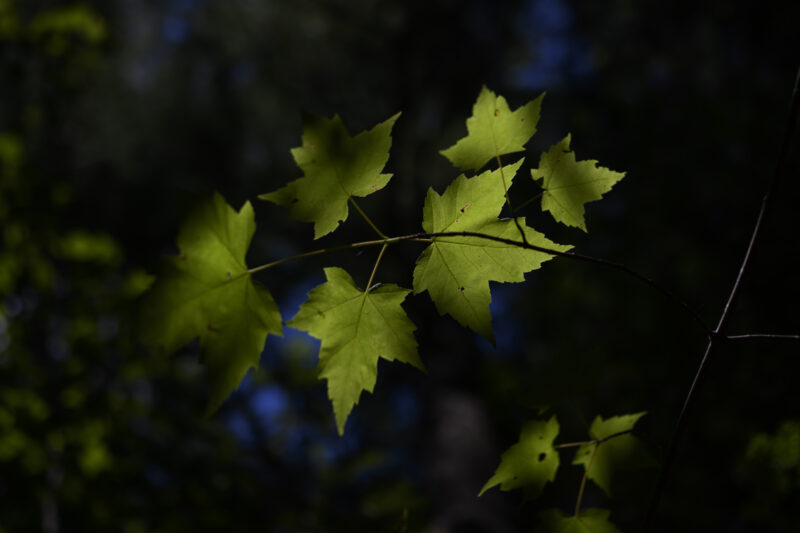
Red maple tree foliage in the Acadian forest at Whaelghinbran Farm near Sussex, N.B. Photo: Darren Calabrese / The Narwhal
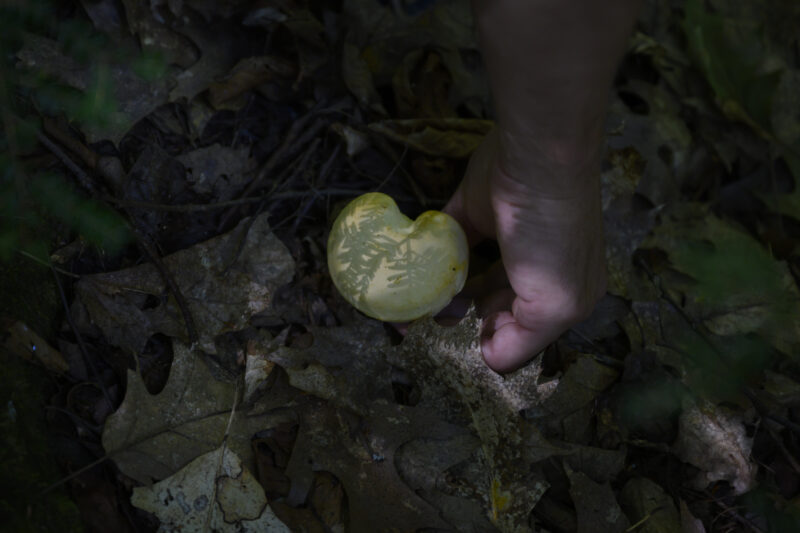
Hemlock needles form a shadow on a mushroom cap that D’Orangeville picks in Odell Park in Fredericton. Photo: Darren Calabrese / The Narwhal
This new normal for forests in the Maritimes is such that many, including me, have fostered little to no appreciation for the Acadian forest.
“People don’t miss what they don’t remember,” Hardie says.
Species like hemlock and black ash are already disappearing and so may the red spruce, the flagship of the Acadian forest.
Global changes have led to new invasive insects. There’s one moving up from the United States that is gradually killing off the remaining hemlocks, which are expected to be gone in a decade, D’Orangeville says. And a wood-boring beetle native to East Asia is currently wiping out black ash, used by Mi’kmaw to make baskets.
“People don’t miss what they don’t remember.”
While restoring Acadian forests can help mitigate climate change, at the same time, climate change is also threatening the forest. The shift to a warmer climate means more temperate hardwoods like oaks and maples are growing in greater abundance and there are fewer boreal species. Now, D’Orangeville says, the shift is happening faster than ever before.
“We have on pretty good evidence that the boreal species are going to retract and the more temperate species are going to take over,” he says.
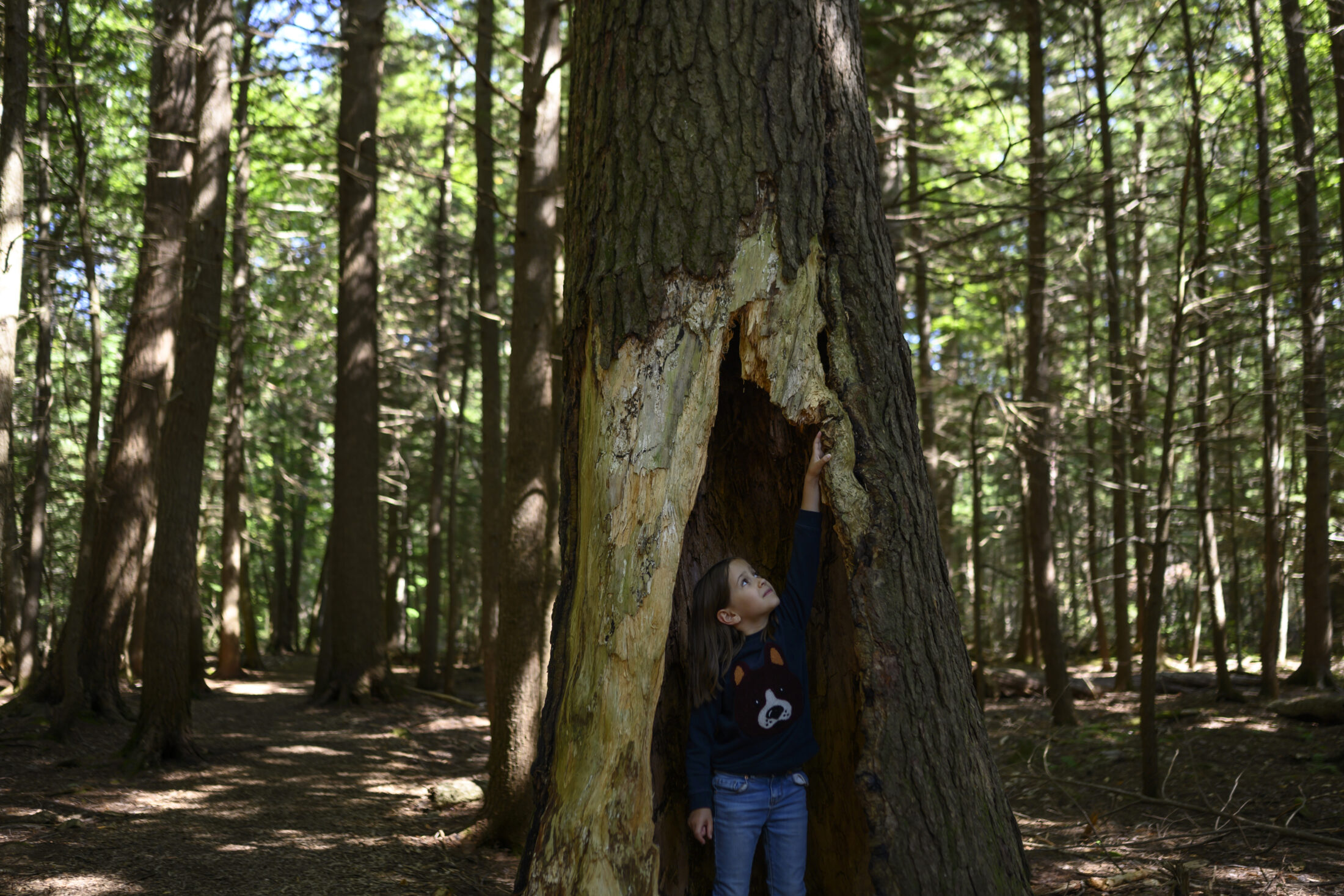
Elise D’Orangeville explores a naturally hollowed-out hemlock tree in Odell Park in Fredericton, N.B. Photo: Darren Calabrese / The Narwhal
Some studies show the capacity of trees to produce seeds for migration and continue the growth cycle is 10 times slower than climate change. The risk to the Acadian forest is that some species won’t be able to track the speed of climate change outside of their current distribution range. Red spruce will migrate northward as the climate in the south becomes too warm and the northern climate becomes more suitable.
“Trees just don’t have the capacity to migrate as fast as climate is warming,” D’Orangeville writes in an email.
Mitigating the climate crisis is about two things: drastically reducing fossil fuel emissions as soon as possible and restoring natural ecosystems. In 2015, Canada and 194 other countries adopted the Paris Agreement, which aims to hold the global average temperature rise to below 2 C above pre-industrial levels to prevent catastrophic environmental consequences. At the time, Canada committed to reducing its annual greenhouse gas emissions by 30 per cent by 2030.
Right now, the carbon market is relatively small and voluntary but that may soon change. The value of the global market for carbon emissions could soar from $600 million now to $200 billion by 2050, said the German bank Berenberg, as countries hit the limits of decarbonization and need to rely on offsetting projects to meet national and corporate targets, wrote S&P Global.
The lack of a carbon market in Atlantic Canada currently is the biggest barrier to Community Forests International’s vision to restore the Acadian forest through carbon offsets. The charity not only needs woodlot owners willing to take part in their carbon offsetting program, but customers to buy those carbon offsets. But Hardie and de Graaf have reason to be hopeful. The federal Liberal government has implemented a price on carbon pollution and is currently developing rules for greenhouse gas emissions offset systems, which Hardie says will include forests — just one avenue for storing carbon.
In another hopeful sign, a 2011 New Brunswick survey of non-industrial forest owners showed money isn’t always the top priority for family woodlot owners. Many value the forest for walking and wildlife and want to leave it for future generations.
Ed Murray, 79, is one of them. He spent his working life in forestry and trucking in southern New Brunswick before leaving the business to his son Rick. Still, Murray has a sentimental attachment to the 607 hectares of forest he still owns and wants to leave a legacy for his 14 grandchildren and three great-grandchildren.
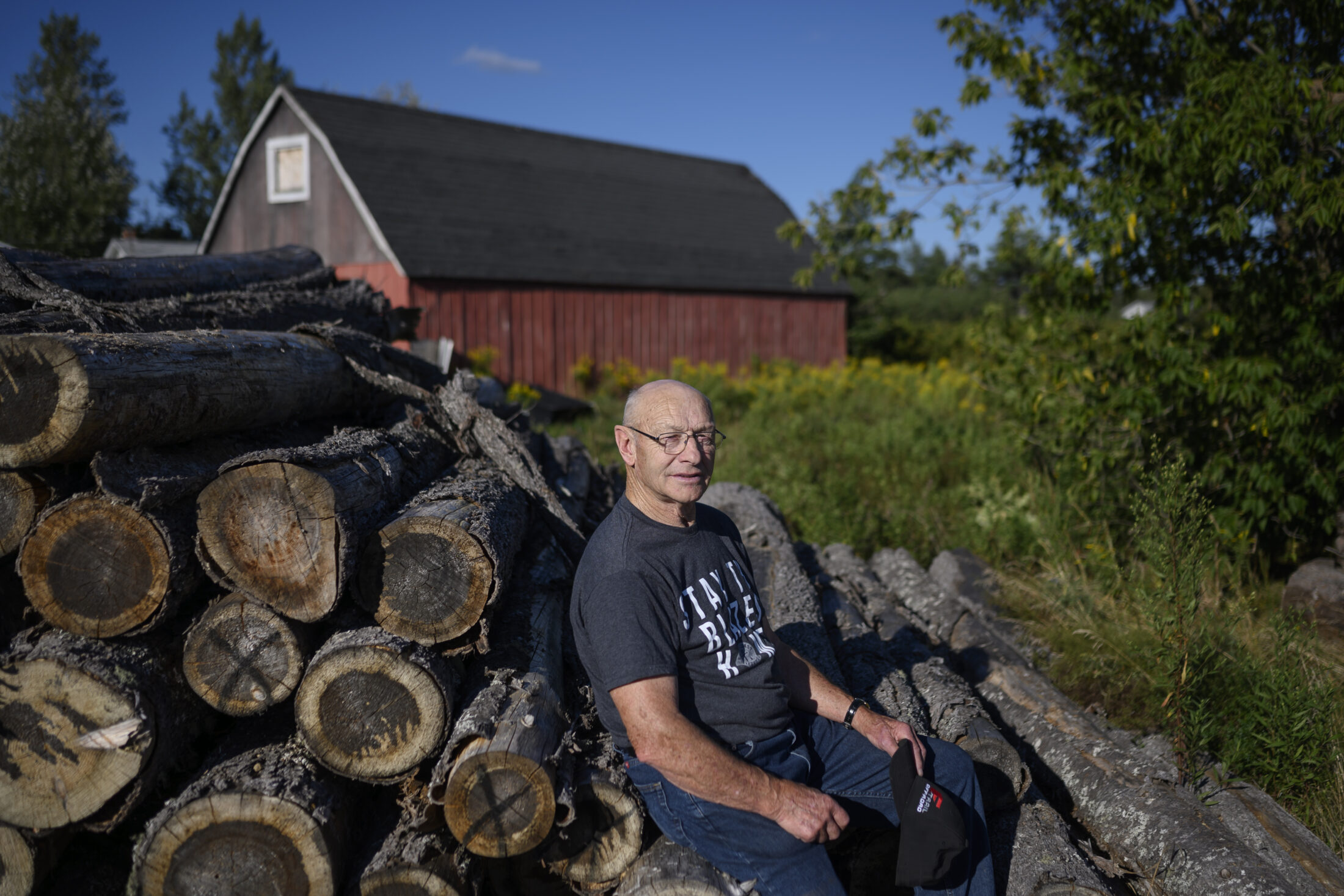
Ed Murray, a family forest owner in New Brunswick, wants to leave a legacy for his children and grandchildren. Photo: Darren Calabrese / The Narwhal
On the back porch of his home in Penobsquis, N.B., wind chimes tinkle and tractor trailers rumble in the distance as he tells me how the industry has waxed and waned since he started working for his father in 1963.
“Small woodlot owners were the backbone of rural New Brunswick for years and years and years. The rural people — the farmers and the woods people and the fishermen — they’re the reason that cities are there,” he says. “At one time, I was a clear-cutter. I’m getting further away from that all the time.”
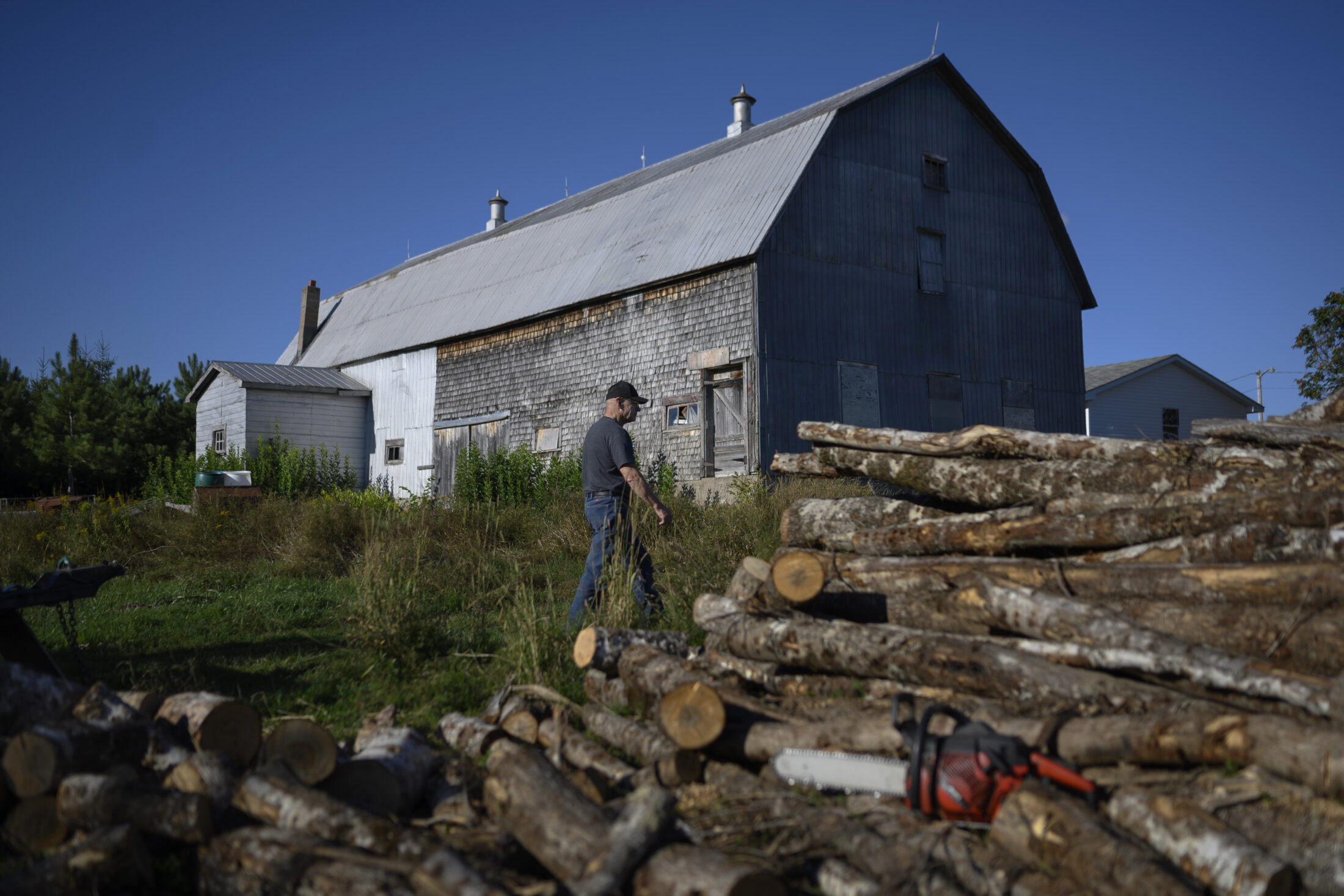
Murray walks past a pile of maple trees cut for firewood on his property. “At one time, I was a clear-cutter. I’m getting further away from that all the time,” he says. Photo: Darren Calabrese / The Narwhal
Recently, Murray volunteered to have the carbon measured in 242 hectares of his forest, which, over the years, he’d been cutting selectively and restoring to a natural Acadian forest. He wanted to preserve it for the next generation but when he discovered that his property wouldn’t meet the base level required to start earning carbon offsets for another three years he was upset and disappointed. “I said ‘I want to do as I please with my property.’ ”
Then there’s Kevin Veinotte, 51, whose family has been managing 161 hectares of forest for seven generations. His footprint on the forest has been much lighter. When harvesting in the forest in West Northfield in southern Nova Scotia, Veinotte uses lightweight equipment — a farm tractor, chainsaws and horses until recent years — to avoid disturbing the ground, and he only does so in winter and early spring months to leave the owls, red tail hawks and a northern harrier alone during nesting season.
“We have a rich diversity of wildlife and I really enjoy that,” Veinotte says. “It gives me a lot of pride in being able to earn a living doing this and not wreaking havoc on everything around us. We’ve got beautiful clean streams running through our farm. I want to keep it that way.”
He also owns 25 acres of Christmas trees, an abattoir and 40 hectares of agricultural land for cattle, sheep, free range chickens and turkeys. He manages his forest in such a way that it spreads income over his life.
“It’s the way we’ve always managed our woodlot,” says Veinotte, who is teaching his sons, who are in their 20s, how to carry on the legacy. “It’s the reason that I have wood to cut today is that’s how my father managed it.”
The wood Veinotte cuts from big trees is sold for home-building or projects that preserve the carbon for a long time, as opposed to toilet paper and paper. He says he’s interested in selling carbon credits if the opportunity comes up. “It’s a nice fit,” Veinotte says. “Where we’re growing large, long-lived trees that will grow a long time, it has the opportunity to lock down a lot of carbon.”
For Hardie of Community Forests International, that’s good news. He hopes people like Veinotte and Murray, lifelong woodlot owners, will be part of a movement among the tens of thousands of people who own forest in the Maritimes.
“There’s some pretty big economic and social things that need to shift, but if we do it, we can make this globally significant contribution — stabilize our climate — which is pretty much the most important thing we could be doing right now,” Hardie says. “If we do it in a way that also creates new economic opportunity, especially for our rural economies, it just makes it a little easier for people to forgo clear-cutting.”
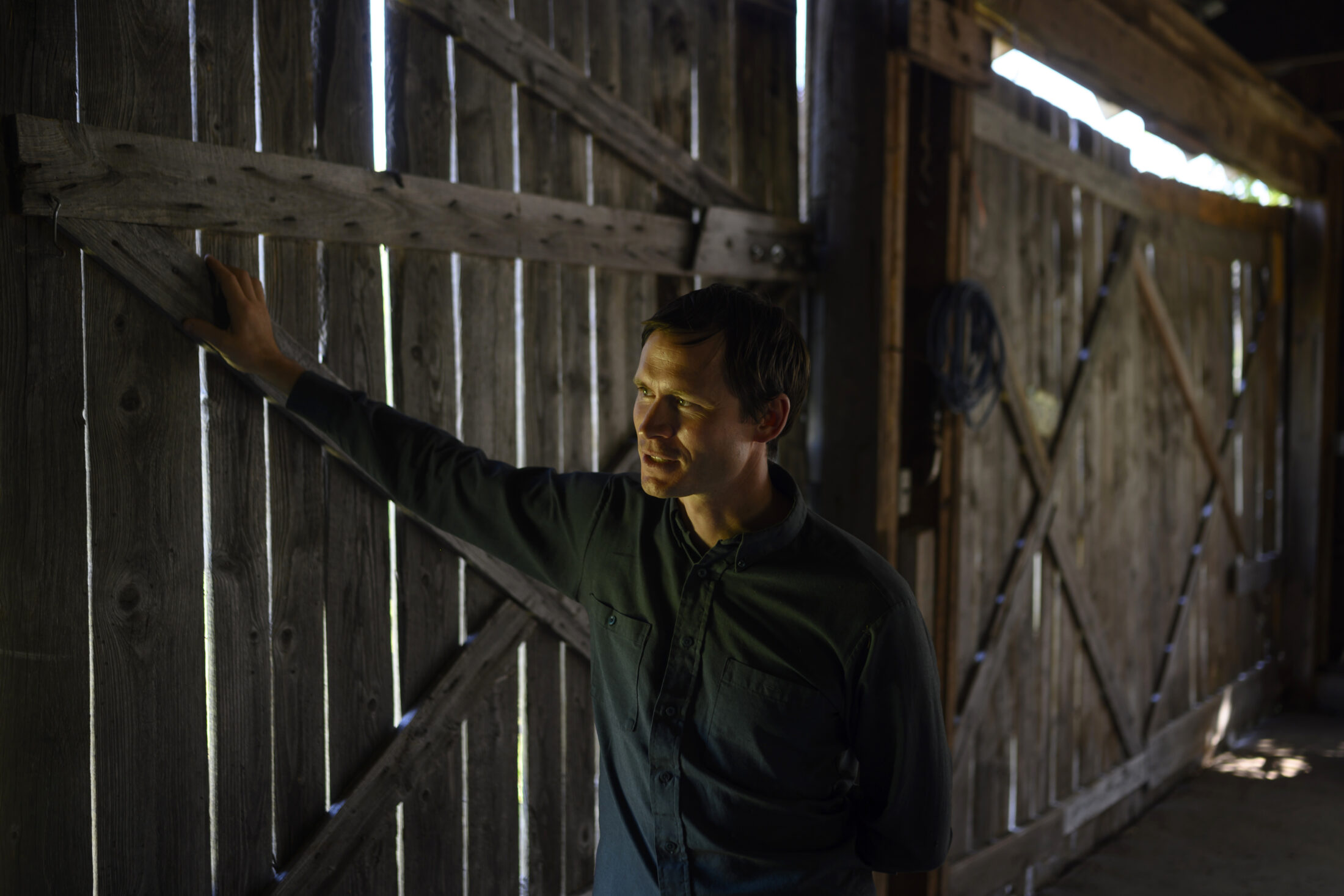
Hardie says saving the Acadian forest can make a “globally significant contribution” in the fight against climate change. Photo: Darren Calabrese / The Narwhal
Back at the Wildcat River in southern Nova Scotia, Melissa Labrador tells me she sometimes feels like she is in a race against forestry and land clearing. She spends much of her time educating people, teaching workshops and taking scientists out into the forest to explain the importance of the Acadian forest for her people.
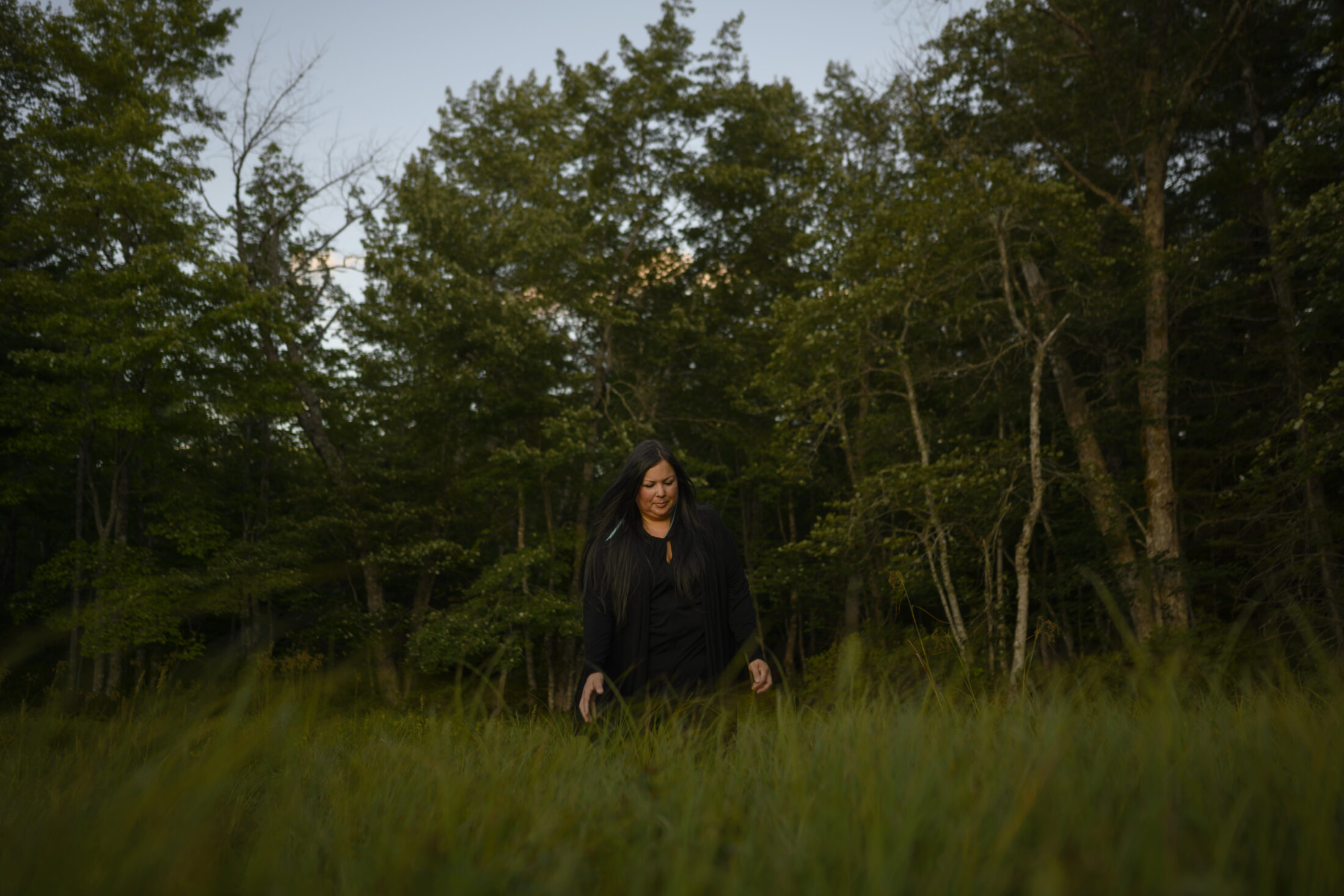
Labrador is teaching her children about the medicinal plants in the Acadian forest. “If my people didn’t understand the medicines, we wouldn’t be here,” she says. Photo: Darren Calabrese / The Narwhal
In the cool, dry forest near her home, she picks a frond of sweet fern, which is used to heal blisters from poison ivy and acts as an immune system booster. She also shows me bracken fern, used as a nerve tonic. She tells me about the beech tree leaves, which are used to dry up the lungs, and gold thread, an anti-inflammatory used to treat jaundice and mouth sores. Her daughter, Nakuset, trails us, taking notes while her son, Tepkunaset, plays on the shallow edge of the river. For a treat, Labrador digs up a small white tuber she calls Indian cucumber and we break off quarters, enjoying its remarkable crisp sweet cucumber flavour.
“It’s not just the medicine here,” Labrador says as the birch leaves swish and the river swirls. “It’s the act of being in the forest, breathing in all the compounds from the trees and everything around us. Picking the medicine is a treat. Being in the forest is the medicine.”
The Carbon Cache series is funded by Metcalf Foundation. As per The Narwhal’s editorial independence policy, the foundation has no editorial input into the articles.
Get the inside scoop on The Narwhal’s environment and climate reporting by signing up for our free newsletter. On a warm September evening nearly 15...
Continue reading
10 billion litres of sewage are dumped into Winnipeg’s lakes and rivers each year. Some...

Court sides with Xatśūll First Nation, temporarily halting Mount Polley mine waste expansion

Break out the champagne: Emma’s storied life and leadership in journalism has earned her the...
